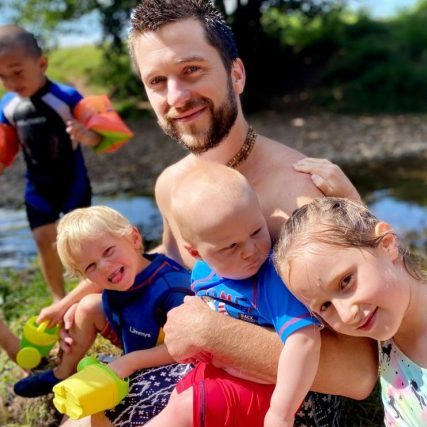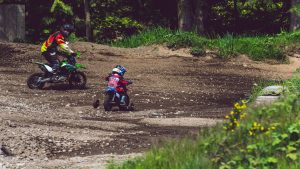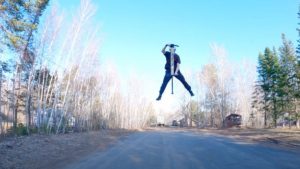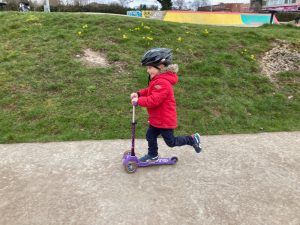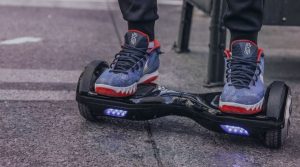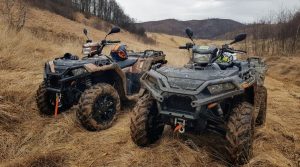Yes, pogo sticks can be dangerous. But, no, that doesn’t mean your family should ditch them.
Childhood wouldn’t be quite the same without a pogo stick. So instead of preventing your children from using them, you may instead choose to embrace the developmental benefits of risky play 1Risky play for children: Why we should let kids go outside and then get out of the way https://www.cbc.ca/natureofthings/features/risky-play-for-children-why-we-should-let-kids-go-outside-and-then-get-out while at the same time teaching your children how to assess hazards and take sensible steps to minimize danger.
If you decide to go for this approach, then this guide will help you to keep your child as safe as possible on their pogo stick.
What are the dangers of pogo sticking?
Intuitively, kids jumping up and down while trying to balance on a springy rod will involve knocks and bumps. Kids will fall off, often onto cement driveways. This is largely unavoidable, however, most children will self-regulate. That is, they will learn their capability and physical limits and then keep within them.
Typical injuries involve:
- Bruises
- Scrapes and grazes
- Twisted ankles
- Head impacts
Most of these can be dramatically mitigated by wearing appropriate safety gear, namely: CPSC-certified helmets; long-legged/armed clothing, and; properly fitted appropriate footwear.
So regular pogo sticking involves some risk, comparable to riding a bike. Extreme pogo sticking, however, is another matter. This needs to be approached and respected in the same way other extreme sports are (eg, skateboarding, pro scooting, BMX, etc).
Children and young people embarking on any extreme sport need to be aware of the significant risks of injury. And indeed, most are. The key advice to parents is to talk frequently and openly to your child about the risks. Make sure they are respecting the dangers and that they are committed to wearing appropriate safety gear and following safety guidelines.
Essential safety gear
Safety gear is non-negotiable. Here is a list of the essential gear that children need when using a pogo stick:
- [Essential] CSPC certified helmet. Your child should have one of these for any ride-on toy. Always opt for CSPC certified over aesthetics and make sure their helmet is fitted properly. It should fit snugly and be unable to tip or twist out of position. Makse sure it sits squarely atop their head and doesn’t tilt back. This ensure forehead protection.
- Knee and elbow pads. Pros tend not to use these, but for first-timers and children who are still learning, these are a sensible piece of safety gear.
- Long-legged/armed clothing. Again, a good option for learners who are likely to come off the pogo many times. These will save many grazed elbows and knees.
- Properly fitted shoes. Skate shoes are ideal as they are nice and tough. Always opt for covered toes (eg, sneakers but not sandals). Make sure they are done up tightly so that the ankle is protected and the foot can’t slip around
Safety DOs and DON’Ts (from pogo pros)
Here is a summary of the safety advice given by the biggest pogo stick brands in the world.
Parents, it’s a great idea to get to know the following safety guidelines intimately. Then teach your child and help them develop a proactive safety culture.
- DO NOT pogo in streets and parking lots. Avoid anywhere used by vehicles.
- DO NOT pogo near people. Avoid practicing near people. A falling body or pogo stick can easily injure a passer-by.
- DO NOT pogo on slippery surfaces. Never ride your pogo stick after it has rained or, more generally, on wet surfaces. Also avoid terrain with loose gravel, sand, or leaves. Any loose debris can cause slips.
- DO NOT pogo on weak surfaces. The pressure exerted at the tip of the pogo stick can be huge. Avoid wood floors, gardens, ice, roofs, etc. A good rule of thumb is to only use surfaces you’d be happy to drive on.
- DO avoid overhead obstacles. Make sure you jump in an area without any overhead obstacles or low ceilings. Typically your head can reach 10 to 12 feet.
- DO pogo on level ground. The safest ground is level. Avoid steep inclines. Jumping on angled surfaces reduces the friction between a pogo stick and the ground and means slippages are more likely. Also, avoid uneven surfaces, which are unpredictable and will often cause problems
- DO learn your limit. Like any skill, you need to build up slowly. Respect the natural learning curve and don’t attempt tricks or stunts until you have worked your way up to them with plenty of practice.
- DO check and maintain your pogo stick. Before each ride, give your pogo a once-over. Check that all nuts, bolts, and connections are secure; the handlebars and footpegs are tight, and; that there is no visible sign of damage.
That’s it! Keeping your child safe on a pogo stick is mostly common sense. The understanding of risk and the steps taken to mitigate it apply equally well to most other outdoor, active ride-on sports. Teaching children how to assess and respect risk, and building a culture of proactive safety precaution is a skill and habit that will benefit them throughout their lives.

